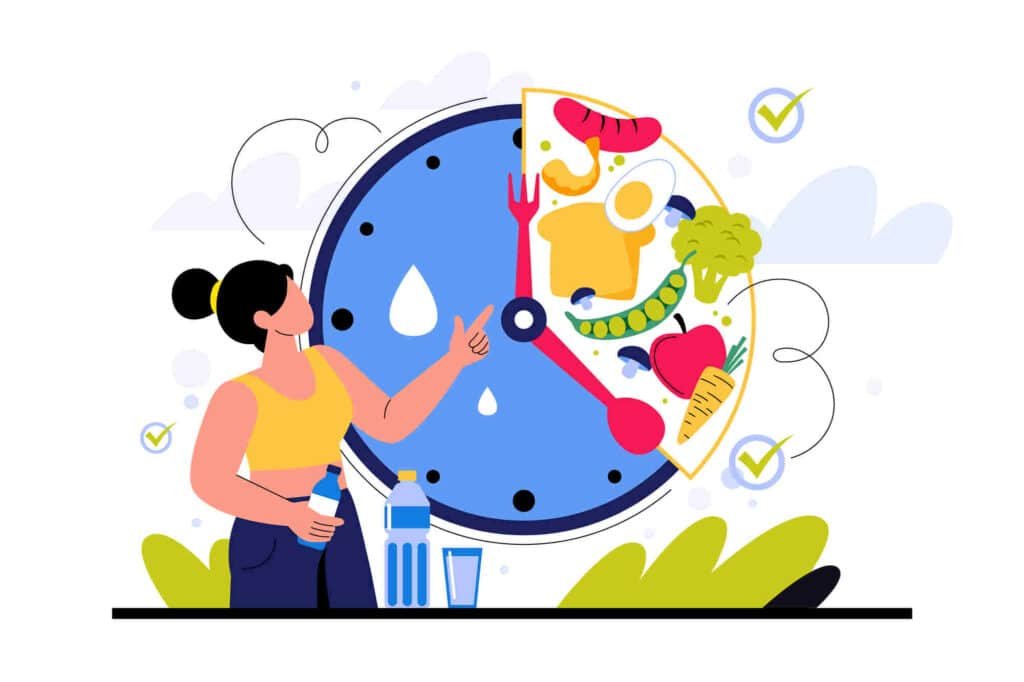Introduction
You’re a woman in your 50s, full of ambition and wisdom, but your body feels like it’s playing tricks on you. The scale won’t budge, energy slumps hit by 3 PM, and mood swings make you feel like a stranger to yourself. You’ve tried every diet, but nothing sticks, especially now, as hormonal shifts and slowing metabolic rates rewrite the rules. But what if there’s a strategy that works with your changing biology, not against it? Welcome to intermittent fasting (IF), a flexible, with health benefits approach to reclaiming your energy, health, and confidence. Let’s dive into the interesting topic of the day, best intermittent fasting for women over 50.

Why Women Over 50 Need a Different Playbook
Aging is a journey of transformation. For postmenopausal women, plummeting estrogen levels trigger insulin resistance, redistribute fat to the belly, and heighten risks of heart disease and metabolic syndrome. Research shows metabolic rates drop by 1-2% per decade after 30, and even slight calorie excesses lead to weight gain. Traditional calorie-restriction diets often fail here because they ignore hormonal chaos and muscle loss.
Intermittent fasting, however, is a fundamental change. By cycling between fasting periods and eating windows, IF taps into your body’s innate repair systems. Human studies reveal it boosts insulin sensitivity; reduces stubborn fat cells, reduces chronic inflammation, avoids the risk of high blood pressure, and enhances good mental health and healthy weight. For women over 50, this isn’t just about weight loss, it’s about rewriting your health story. Following Intermittent fasting for the long term will be a good idea to benefit your overall health.
The 5 Best intermittent fasting for women over 50
Not all fasting plans fit every lifestyle. Choosing the best intermittent fasting schedules with nutritious foods is significant for every woman. However, based on the health conditions and to avoid any potential risks opting for the suitable IF among the different types of intermittent fasting is a must. Here’s how to choose your match:
1. The 16:8 Method (Time-Restricted Eating)
– How It Works: This method involves fasting for a total of 16 hours each day, allowing you to eat during an 8-hour window, such as from 10 AM to 6 PM. This approach offers a structured yet flexible eating schedule. Having essential nutrients during your eating window is advisable.
– Why It Shines: The 16:8 Method is appreciated for its simplicity and sustainability. It’s easy to adapt to your lifestyle. During the fasting phase, you can enjoy black coffee (natural sweeteners like monk fruit) or herbal tea, which can help diminish feelings of hunger. When it’s time to eat, prioritize nutrient-dense foods that nourish your body, including leafy greens, lean proteins like salmon and chicken, wholesome grains such as quinoa and oats, and healthy fats found in avocados and nuts.
– Science Says: Findings from a 2023 study published in “NLH” highlighted those women over the age of 50 engaging in the 16:8 method lost 3% more body weight while also experiencing improved insulin sensitivity compared to those who did not practice fasting.
2. The 5:2 Plan (Modified Alternate-Day Fasting)
– How It Works: With this plan, you eat normally for five days a week, followed by two non-consecutive days in which you restrict your calorie intake to 500-600 calories. This structured approach allows for nutritional flexibility during your regular eating days.
– Pro Tip: To maximize the effectiveness of this plan, schedule your fasting days on days when you have lower activity levels. Focus on consuming protein-rich foods like tofu and eggs, as well as high-fiber options such as broccoli and berries to help you feel fuller for longer.
– Why It Works: A trial conducted in 2021 and published in *JAMA* showed that postmenopausal women following the 5:2 plan reduced their body fat by an impressive 7% and experienced significant drops in LDL cholesterol levels over just 12 weeks.
3. The 12-Hour Fast (Beginner’s Gateway)
– How It Works: This method involves fasting for 12 hours, from 7 PM to 7 AM. By syncing this fast with your body’s natural circadian rhythms, the approach not only supports better sleep but also serves as a gentle introduction to intermittent fasting.
– Ideal For: This plan is well-suited for women who are new to fasting or those with sensitive metabolic systems, making it an approachable starting point.

4. The 14:10 Method (Gentle Time-Restricted Eating)
– How It Works: The 14:10 method consists of fasting for 14 hours each day and allowing yourself to eat within a 10-hour window, such as from 8 AM to 6 PM. This method offers a balance between structure and freedom.
– Perfect For: This method is ideal for those who need more flexibility in their eating schedule. Research indicates that even a fasting duration of 14 hours can lead to improved blood sugar levels and reductions in belly fat.
5. The Crescendo Method (Fasting 2-3 Days Weekly)
– How It Works: This unique approach centers around fasting for 12 to 16 hours on 2 to 3 non-consecutive days each week, for example, Monday, Wednesday, and Friday.
– Why It’s Unique: What sets the Crescendo Method apart is its ability to balance the benefits of fasting with your regular eating patterns, thereby preventing any potential metabolic slowdown that might occur with prolonged fasting. This makes it a manageable option for those looking to incorporate fasting into their lifestyle without feeling deprived.
The Life-Changing Benefits of Intermittent Fasting After 50
Sustainable Weight Loss & Fat Loss: Ditch the yo-yo diet rollercoaster. IF promotes fat loss while preserving lean muscle mass—critical as muscle declines with age. A 2023 study in Cell Metabolism found women over 50 practicing time-restricted eating (16:8) lost 3.5% more body fat and maintained muscle compared to calorie-restricted peers.
Hormonal Harmony & Insulin Sensitivity: Menopause often brings insulin resistance, a driver of weight gain and type 2 diabetes. IF stabilizes insulin levels, improves glucose tolerance, and may even mimic estrogen’s protective effects on heart health.
Heart Health & Disease Prevention: Lower LDL cholesterol, blood pressure, and inflammation? Yes! IF reduces risks of cardiovascular disease—the #1 killer of women—by improving metabolic health.
Brain Boost & Mental Clarity: Emerging research links IF to reduced risks of Alzheimer’s disease. Stable blood sugar levels mean fewer mood swings, sharper focus, and a resilient mind.
Longevity & Immune Resilience: Fasting triggers autophagy—your body’s cellular “cleanup crew”—slowing aging and strengthening your immune system.
How to Start Intermittent Fasting Safely: Step-by-Step Guide
Step 1: Consult Your Healthcare Provider
Intermittent fasting (IF) is not a one-size-fits-all approach, and it’s essential to ensure it aligns with your personal health circumstances. Before you embark on this journey, have an in-depth discussion with your healthcare provider, especially if you have any of the following conditions:
– Holding a History of Eating Disorder: IF can exacerbate harmful behaviors or thought patterns related to food.
– Diabetes or Hypoglycemia: During the fasting period there can be a significant impact on blood sugar levels, requiring careful management.
– Chronic Health Conditions: Conditions such as adrenal fatigue may be negatively affected by fasting practices.
Step 2: Fuel Your Body with Nutrient-Dense Foods
Your eating window is not an excuse to indulge in unhealthy choices. Instead, focus on incorporating nutrient-dense foods that support your health and energy levels. Prioritize the following food groups:
– Lean Proteins: Foods like salmon, lentils, and Greek yogurt are the best approach for preserving muscle mass while you lose weight.
– Healthy Fats: Incorporate sources like olive oil, walnuts, and chia seeds into your meals to help curb cravings and promote satiety.
– Fiber-Rich Carbohydrates: Opt for foods such as sweet potatoes, quinoa, and raspberries to help regulate your blood sugar levels.

Intermittent fasting plan for meals:
– Breakfast (10 AM): Start your day with a flavorful spinach omelet paired with creamy avocado and a refreshing cup of green tea. A healthy diet accompanied by nutritional needs is a good way to begin your day.
– Lunch (1 PM): Enjoy a hearty grilled chicken salad drizzled with olive oil and served alongside a serving of quinoa for added texture and nutrients. If you are a vegan, not to worry, we got your back.
– Dinner (5:30 PM): Indulge in baked salmon served with roasted Brussels sprouts and a side of wild rice, offering a well-rounded and satisfying end to your eating window.
Step 3: Align Your Fasting with Your Daily Routine
Creating a rhythm within your day can enhance the benefits of intermittent fasting. Here’s how you can synchronize fasting with your lifestyle:
– Morning: Begin your day by hydrating with either lemon water or a cup of black coffee to stimulate your metabolism without breaking your fast.
– Afternoon: Take a brisk walk after lunch. This not only aids digestion but also improves insulin sensitivity and metabolic health.
– Evening: Aim to close your eating window at least three hours before bedtime, which can contribute to improved sleep quality and digestive rest.
Step 4: Combine Fasting with Strength Training
To effectively maintain lean muscle mass during your fasting regimen, incorporate strength training exercises into your weekly routine. Aim for 2-3 sessions per week, focusing on major muscle groups. This will help in preserving metabolic rates and promoting overall body strength.
Step 5: Monitor Your Progress Beyond Just the Scale
Weight isn’t the only indicator of health and progress. Broaden your focus to include additional metrics:
Body Composition: A lot of people find that intermittent fasting and calorie restriction help in reshaping their physique. Regularly measure your waist circumference, track body fat percentage, and monitor your body mass index (BMI) to assess changes in your body’s composition.
Blood Markers: Keep an eye on crucial health indicators such as fasting glucose levels, LDL cholesterol, and blood pressure to ensure your fasting routine is benefiting your metabolic health. Intermittent fasting works by improving insulin sensitivity and supporting cardiovascular health over time.

Energy & Mood: Maintain a journal to record your energy levels and mental clarity throughout the day, providing insight into how the fasting schedule impacts your overall well-being. Many people report increased focus and sustained energy as their bodies adapt to fasting.
By following these steps, you can ensure a safe and effective start to intermittent fasting, helping you achieve your health goals thoughtfully and sustainably.
Avoid These Common Pitfalls
1. Over-Restricting Calories: Don’t Turn Fasting into Starvation
A lot of people assume that the fewer calories they eat, the faster they’ll see results. But severely slashing your intake on fasting days can backfire. When you under-eat, your body perceives it as stress, spiking cortisol levels and potentially slowing down your metabolism. Over time, this can lead to fatigue, irritability, and even stubborn weight gain.
Fix It: Instead of extreme calorie restriction, focus on nutrient-dense, balanced meals during your eating window. Prioritize lean proteins, healthy fats, and fiber-rich foods to keep energy levels stable and prevent cravings. Fasting should be about metabolic flexibility, not deprivation.
2. Ignoring Hunger Cues: Your Body Speaks—Listen to It
Feeling lightheaded, foggy, or overly fatigued? That’s your body telling you something. While mild hunger is normal during fasting, dizziness or brain fog can signal that your blood sugar is dropping too low. Ignoring these signs and pushing through can lead to binge eating later or simply feeling miserable.
Fix It: If you start feeling weak, don’t hesitate to break your fast with a protein-rich snack to stabilize your blood sugar. A hard-boiled egg, a handful of almonds, or Greek yogurt can prevent an energy crash without derailing your fasting routine. The key is to fuel your body smartly, not starve it.
3. Skipping Protein: Protect Your Muscle, Not Just Your Waistline
One of the biggest mistakes that older adults make with intermittent fasting is neglecting protein intake. If you’re not consuming enough protein, your body may start breaking down muscle instead of fat, leading to a slower metabolism and a less toned physique.
Make it a rule to get at least 20–30g of protein per meal. This helps preserve muscle mass, supports recovery, and keeps you fuller for longer. Great protein sources include lean meats, fish, eggs, dairy, legumes, and plant-based proteins like tofu or quinoa. Strength training alongside fasting? Bump up that protein intake even more to maximize muscle retention.
Top 10 Protein-Packed Foods for Intermittent Fasting
| 🥗 Food | 🍽 Serving Size | 💪 Protein Content |
|---|---|---|
| 🍗 Chicken Breast | 3.5 oz (100g) | 31g |
| 🐟 Salmon | 3.5 oz (100g) | 25g |
| 🥚 Eggs | 2 large eggs | 12g |
| 🍦 Greek Yogurt | 1 cup (245g) | 20g |
| 🧀 Cottage Cheese | ½ cup (113g) | 14g |
| 🥢 Tofu | 3.5 oz (100g) | 10g |
| 🌾 Quinoa | 1 cup cooked (185g) | 8g |
| 🥣 Lentils | 1 cup cooked (198g) | 18g |
| 🌰 Almonds | ¼ cup (28g) | 7g |
| 🎃 Pumpkin Seeds | ¼ cup (30g) | 8g |
4. Neglecting Hydration: Don’t Mistake Thirst for Hunger
Many people confuse dehydration with hunger, leading them to eat when all they really need is water. Fasting naturally depletes your body’s fluids, and if you’re not replenishing them, you could experience headaches, sluggishness, or even muscle cramps.
Drink plenty of water throughout the day and consider herbal teas or electrolyte-infused water to keep hydration levels up. A pinch of sea salt in your water can also help maintain electrolyte balance, especially if you’re following a low-carb diet. If you’re constantly feeling drained, dehydration might be the culprit, not fasting itself.
Real Success Stories: Women Like You
At 41, Melissa faced significant health challenges, including high blood pressure and a suspected mini-stroke. Weighing 238 pounds in June 2021, she turned to intermittent fasting as a solution. Over 10 months, Melissa lost over 100 pounds, reaching 136 pounds by March 2022. She reported increased energy, improved self-control, and a newfound passion for life. Melissa emphasized that intermittent fasting became an integral part of her identity, allowing her to enjoy food without overindulging and leading to a healthier lifestyle.
Laurie Lewis experienced significant weight loss and health improvements through intermittent fasting. She lost and maintained a 50-pound weight loss using this transformational technique. Her journey highlights the effectiveness of intermittent fasting for sustainable weight management.
“Intermittent Fasting for Women” by Patricia Nestor
If you’ve been struggling with stubborn weight, low energy, or frustrating hormonal shifts, this book is your answer. Designed specifically for women’s unique bodies, hormones, and metabolism, it goes beyond basic diet advice. It’s a powerful blueprint to help you burn fat, boost energy, and regain control of your health.
With science-backed strategies and real-life success stories, this guide makes intermittent fasting simple, effective, and sustainable.
It’s time to stop feeling stuck and start transforming your body and mind. Take the first step toward a leaner, healthier, and more confident YOU.
👉 Grab your copy today!
Your Invitation to Begin
Intermittent fasting can be a game-changer for women over 50, helping with weight loss, metabolic health, and reducing the risk of chronic diseases. But here’s something crucial, losing weight shouldn’t mean losing muscle. Strong muscles aren’t just about looking fit; they’re essential for mobility, strength, and overall health as you age.
The problem? If you’re fasting but not hitting your protein goals, you could be doing more harm than good. To preserve muscle, focus on resistance training and prioritize protein, especially in your first meal after fasting. Animal-based proteins offer the most muscle-supporting amino acids, but you can still meet your needs with a mix of plant-based sources.
If you are still sure that intermittent fasting is the right approach for you or not, then we are here to support you at wealthandhealth mastery, which can be a great resource for determining what works best for your body when it comes to fasting. Reach out to us to know more and share this with your loved ones.



